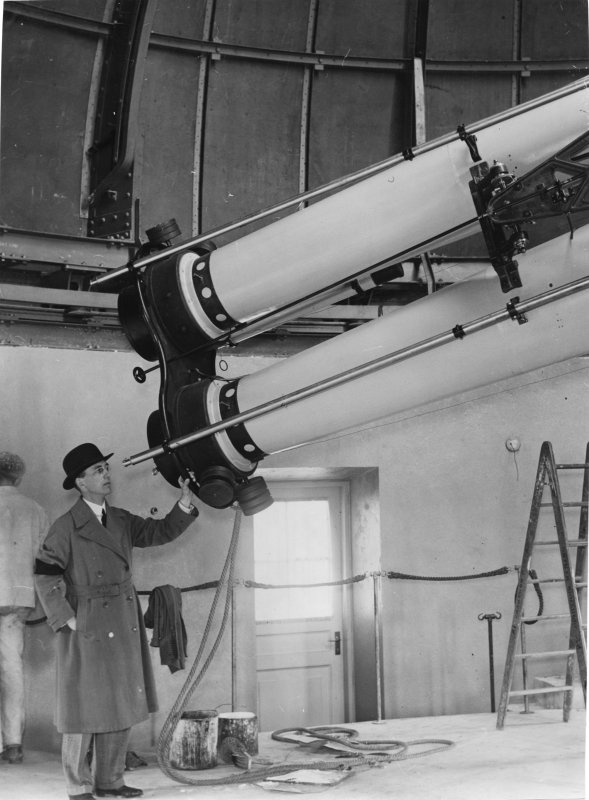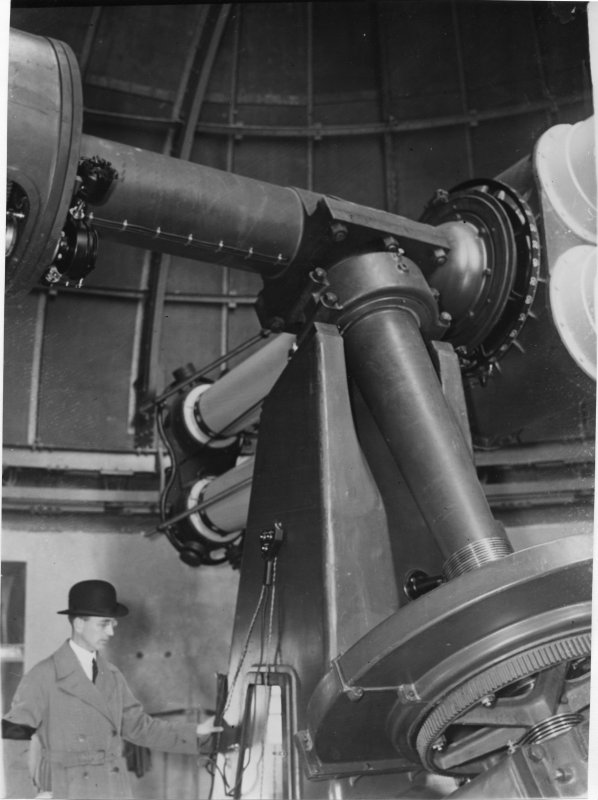Observatories that I have visited:
|
Content:
|
2.2: Main building, double refractor guided tourA while ago I talked to the staff that take care of the old observatory buildings if it was possible to enter inside and take photos of the telescopes at Saltsjöbaden. But this was during the Covid and here is also a school. Not so easy to get inside. Now two years later the Covid risk is almost eliminated and they held an Open House here at September 2022 with guided tours. 
We start at the main building where the double refractor observatory is placed on the backside. Uno will be our guide here. Uno worked at the Astrophysics Institution already when I did my astrophysics studies here during the 1990s. He told me later that he started working here even earlier, the 1970s. Entrance Hall:
We get into the building, Gunilla is talking to the other guide, Lars-Erik. Look at the beautiful hall. The architect Axel Anderberg designed this building and he designed other famous buildings in Sweden too. More to read about Axel Anderberg:

Up at the ceiling is this glass window, the Three Crowns are there, a signature for Sweden. Around in a circle are the twelve zodiac signs. 
Those who arrange the exhibition today are the amateur astronomy club EAF, Ericsson Astronomi Förening.
Library:Before the guided tour starts we sneak into the old library. In the opening to the library this man watch us. 
Pehr Wilhelm Wargentin, a Swedish astronomer. He lived in the 18th century, long before this observatory was built. More about Pehr Wilhelm Wargentin:

In this library I spent countless of hours reading the old books about astronomy, that was in the 1990s. 
Today most of the astronomy books are gone, little bit sad because it's not the same feeling now to be here. But all the wooden work is still here and it's really beautiful. Double Refractor Dome:
Now all visitors are collected who want a guided tour. We climb up the staircase to the telescope dome. |

It's a long spiral staircase, after two levels we stop and waiting for Uno to lock up the door to the dome room. 
One more staircase, a warning sign, not more than 15 people at the same time. 
One more narrow staircase, another door protect us to enter the floor in the dome. The floor is like an elevator and the floor must be parked at bottom before we enter. 
Inside the dome and the big double refractor in front of us. It's big, but wasn't it even bigger 25 years ago when I saw it for the first time ?  Credit:
Observatoriet i Saltsjöbaden Digitaltmuseum / Tekniska Museet
Credit:
Observatoriet i Saltsjöbaden Digitaltmuseum / Tekniska MuseetPhotographer: Unknown This photo can be from 1936 and it looks like the building isn't finished yet. Compare with the photo above, not much difference, a few extra devices had been added during the 85 years. 
The telescope is of an achromatic lens type design. Lens telescopes are always much heavier compare to reflection telescopes and couldn't be built much bigger than this. The lenses are 60 and 50 cm in diameter. One of the biggest in the world, the biggest has a 1 meter lens. More about Achromatic lens:

The telescopes stand on this 4 ton fundament, the telescopes itself weight 7 ton. There is a wooden framed glass door into the mechanic devices. Today you don't find this design at industry devices. Warning signs was not needed 85 years ago, today we must take care of our astronomers much better.  Credit:
Observatoriet i Saltsjöbaden Digitaltmuseum / Tekniska Museet
Credit:
Observatoriet i Saltsjöbaden Digitaltmuseum / Tekniska MuseetPhotographer: Unknown 85 years ago it looked like this. The big shaft to the right is the RA axis, adjusted to be parallel with Earth's axis with high precision. 
I can see some more modern devices added, or modern, even this is old, maybe 40 years. Just wonder what the black knob was used for ? 
Uno has a lot to tell about the telescope, it's not the first time he have guided tours. |

The DEC shaft with its counter weight. 
The joint between the RA and DEC shafts, big bearings with high precision hold them together. 
The big spur gear is used to rotate the RA shaft. One revolution in 23 hours and 56 minutes, it's called sidereal time. Or one star day as I say sometimes when I want to explain why it's not 24 hours. More about Sidereal time:

More doors to access the devices inside the fundament. 
There are several counter weights around the telescope tubes. It's important to have this 4 tons telescope in perfect balance, otherwise the motors will be overloaded and the time precision too low. 
The big show starts, Uno opening the hatches on the dome. 
A big slit opens in the dome and let the light in. 
From the bottom and up are moveable screens to limit the opening to only have the telescope to see through out to the stars. |
|
Advertisement / Annons: |

The telescope is manufactured by Grubbs Parsons & Co. One refractor is used for visual observations and the other for photographing. In that time in the late 1920s these instrument was the best you could buy, top of the art. More about Grubbs Parsons & Co Ltd:

Why are there two refractors, must it not be more than twice so expensive ? Yes, but when this observatory was built with very high demand. One of the refractors are optimized to the yellow wave length where our eyes are most sensitive, the upper telescope. The other is optimized where the photo emulsion on the photographic plates are most sensitive, blue I think. The "film" is glass plates, maybe 180x180 mm, compare that to a big digital camera with full frame sensor, 36x36 mm. The field of view, FOV, of this telescope is comparable to a 1600 mm telephoto lens attached on a full frame digital camera, about one of my telescope's data. One female astronomer who worked with this telescope was Aina Elvius.

The photographic telescope with its glass plate holder. The eyepiece maybe used to get the photographic plate in perfect focus, or it can be to just get a view. 
The visual telescope, the focus drawer looks to be a modern amateur focus drawer type of high precision. The focal length of the telescopes is 8.1 m, or 8100 mm. In the middle of 1990s I helped professor Gösta Gahm to prepare this telescope for a guest group of people. At this time the planet Jupiter was up on the night sky, I took a look and got very impressed. I don't remember the focal length of the eyepiece but maybe 25 mm, that give a magnification of 8100/25 = 324. How many have seen Jupiter at 8100 mm without a Barlow lens ? 
To power the motors and other devices on the dome which rotate they use this electric rail to transfer the electric power over to them. 
Below the service hatch is the adjuster of the azimuthal angle. This is one of the devices where you adjust the RA shaft to be parallel to Earth's axis. 
The remote control of the telescope, a little bit bigger than the TV remote. And this is the modern version ! 
I don't think they have used this telescope much after the 1970s more than for educational use. During the 1970s the NOT telescope at La Palma was built, much bigger telescope at a much darker place. I have been there once, an 18 hours flight with three changes at that time, NOT La Palma. |

Gunilla looking up to the telescope, to reach it the floor must be elevated up at least two meters. That's the reason to have the staircase in the background. To get out on the floor the correct glass door must be opened, that one that is in level with the floor. 
The counter weight to the floor elevator, still working after 85 years. 
There are six of these lifters attached to the floor. The maximum load on the floor is limited to 1.5 ton or 15 people. 
The show is over, Uno close the hatch. 
Now it's dark inside the dome again, we say good bye to the telescope. We can be very proud to have a big refractor like this in Stockholm and it still working. 
We take the staircase down and go to another door that take us out to the terrace. Observatory Terrace:
From the terrace there is a wonderful view out over the sea. It was on this terrace I took my first digital photo of a comet, the comet Hyakutake. On of the nights it was an Open House here, very lot of people coming to see the comet. Most people believe that a big telescope was needed for this, but a 50 mm camera lens was enough because the comet was about 20 degrees wide with its tale. 
Looking back to the observatory building and its dome. Today amateur astronomers can have a Dobson telescope with mirrors of comparable size as this telescope and they take them out into the dark in their cars ! 
Astronomers coffee place ? 
Looking down from the terrace at Saltsjöbaden. The white building is the hospital. Saltsjöbaden ia a popular place and the houses are really expensive here.
|
|